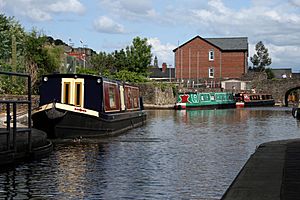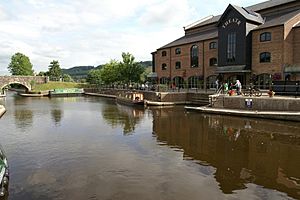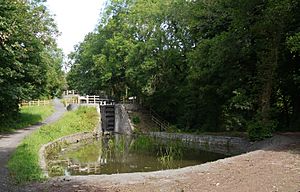Monmouthshire and Brecon Canal facts for kids
The Monmouthshire and Brecon Canal (Welsh: Camlas Sir Fynwy a Brycheiniog) is a beautiful waterway in South Wales. For most of its 35-mile (56 km) length, it flows through the stunning Brecon Beacons National Park. Today, it's a peaceful place, but it was once a busy route for carrying coal and iron. These goods came to the canal on special railways called tramways.
People often call it the "Mon and Brec." It actually started as two separate canals. One was the Monmouthshire Canal, running from Newport to Pontymoile Basin. This included a branch called the Crumlin Arm. The other was the Brecknock and Abergavenny Canal, which went from Pontymoile to Brecon. Both canals were closed in 1962. However, the Brecknock and Abergavenny route, and a small part of the Monmouthshire route, have been reopened since 1970. There are also plans to restore more of the old Monmouthshire Canal. This includes building a new boat area (marina) at the Newport end.
Contents
The Monmouthshire Canal Story
The idea for this canal became official on June 3, 1792. A special law was passed to create the 'Company of Proprietors of the Monmouthshire Canal Navigation'. This company was allowed to raise money to build the canal. The law said the canal would go from Pontnewynydd to the River Usk near Newport. It would also have a branch from Crindau to Crumlin Bridge. The company could also build railways from the canal to any coal mines or ironworks nearby.
Thomas Dadford, Jr. was in charge of building the canal. More laws were passed as the work continued. In 1797, a law allowed the company to extend the canal. This moved the Newport end further south. Another law in 1802 allowed specific railways to be built and helped the company get more money.
The main part of the canal opened in February 1796. It was 12.5 miles (20.1 km) long and went from Newport to Pontnewynydd. It climbed 447 feet (136 m) using 42 locks. A lock is like a water elevator that helps boats move up or down hills. The 11 miles (18 km) Crumlin Arm opened in 1799. It left the main canal at Crindau and climbed 358 feet (109 m) through 32 locks to Crumlin. This included a famous set of locks called the Cefn flight of Fourteen Locks. Later, in the 1840s, a short extension connected the canal to Newport Docks and the River Usk. The locks on this canal were designed for boats up to 9 feet 2 inches (2.79 m) wide and 63 feet (19 m) long.
Many railway branches were built to connect to the main canal. These railways helped bring coal and iron from mines and factories to the canal boats. For example, a 10 miles (16 km) long railway went from Crumlin to Beaufort Iron Works.
The Brecknock and Abergavenny Canal Story
This canal was first suggested in 1792. The idea was to connect Brecon to the River Usk near Caerleon. But the owners of the Monmouthshire Canal suggested a different plan. They wanted the new canal to join their canal at Pontymoile near Pontypool. This way, they could share the route from there to Newport. A law was passed in 1793, allowing the new company to raise money. They could also build railways to connect the canal to mines and ironworks.
At first, they focused on building the railways. John Dadford oversaw the building of lines from coal mines to factories. It wasn't until 1795 that Thomas Dadford became the engineer for the canal itself. Work started in 1796. By late 1797, the canal was open from Gilwern to Llangynidr. However, building costs were higher than expected. Benjamin Outram was asked to check the work and suggest improvements. He recommended rebuilding part of the Ashford Tunnel.
The canal was finished and opened to Talybont-on-Usk in late 1799. It reached Brecon in December 1800. Thomas Dadford died in 1801. The canal company got another law passed in 1804 to raise more money. The section to Govilon, near Abergavenny, was finished in 1805. But they couldn't raise enough money, so construction stopped. The company then focused on running the canal and railways. By 1806, they had 20 boats carrying coal and limestone.
In 1809, the Monmouthshire Canal Company was unhappy that the connection from Gilwern wasn't finished. Help came from Richard Crawshay, a powerful iron master. He lent them £30,000. This money allowed William Crosley to finish the work, and the connection opened in February 1812.
From the Pontymoile junction, the Brecknock and Abergavenny Canal goes through Llanfoist near Abergavenny and Talybont. It ends at a basin in Brecon. The canal is 33 miles (53 km) long. It is mostly flat for the first 23 miles (37 km) to Llangynidr, where there are five locks. Near Brecon, the canal crosses the River Usk on a bridge called an aqueduct at Brynich. One more lock brings the total climb to 68 feet (21 m). The River Usk provides most of the water for the canal.
The Old Tramways
The canals in Wales were often built in narrow valleys. This made it hard to build branches to reach the many mines and factories. But the laws that allowed the canals to be built also allowed tramways to be constructed. These tramways could be built on land bought by the canal company, just like the canal itself. This led to a huge network of tramways. They connected to many coal and iron mines in the area.
At first, the tramways used "edge rails." This meant the wheels had flanges (like modern train wheels) and ran on bar-shaped rails. Later, some were changed to "tram plates," which were L-shaped. But this change wasn't always successful. Eventually, many of these tramways were changed back to standard gauge railways, using flanged wheels again.
Many tramways connected to the Monmouthshire Canal (at least 21). Another 13 connected to the Brecknock and Abergavenny Canal. Some factories even connected to both canals.
Sirhowy Tramroad
In 1800, the owners of Sirhowy Ironworks got permission to build a tramroad to join the canal. This tramroad was built between 1802 and 1805 or 1806. It went from the Sirhowy Ironworks to a point near the canal. A special section, known as the "golden mile," was built across the land of Sir Charles Morgan. He earned money from tolls for goods crossing his land.
A big part of this line was the 'Long Bridge' at Risca. It was 930 feet (280 m) long with 33 arches. This bridge was later removed in 1853. The whole line was changed to standard gauge railway by 1863.
Hay Railway
The Hay Railway was approved in 1811. It took almost five years to build its 24 miles (39 km) long route. It opened on May 7, 1816. This tramway used cast iron 'L'-shaped plates. The railway was built to carry goods and freight, not passengers. In 1860, the Hay Railway became part of the Hereford, Hay and Brecon Railway. The line was then changed to standard gauge for steam trains.
Canal Decline and Re-opening
The canals, with their network of feeder railways, were very profitable for a while. Coal traffic grew from 3,500 tons in 1796 to 150,000 tons in 1809! But then, new railways arrived. This caused the canals to decline. In the 1850s, people even suggested closing them. The Monmouthshire Company bought the Brecknock and Abergavenny Canal Company in 1865. But it was too late. The Monmouthshire Canal slowly closed, while the Brecon line was kept to supply water. Control of the canals went to the Great Western Railway in 1880, and then they became national property in 1948.
Part of the canal from Pontymoile to Pontnewynydd was turned into a railway in 1853. This meant 11 locks were lost, and much of the water supply for the lower canal. Other sections of the canal also closed over the years. The Crumlin branch was closed for boats in 1930. In 1946, a big break happened at Abercarn. Even though the canal hadn't been used there for 16 years, it was repaired. However, the branch closed completely in 1949. Part of it was even filled in to make way for the A467 road in 1968-69. The rest of the canal was officially closed in 1962.
But just two years later, restoration work began! Money for restoration became available because of the National Parks laws. The Brecon Beacons area was a national park, and the canal was seen as a valuable feature. The canal was reopened to Pontymoile in 1970.
The section from Brecon to Pontypool was one of seven canal stretches that were improved in 1968. The Cefn Flight of Fourteen Locks is very important. It's on Cadw's list of Scheduled Ancient Monuments.
Restoration of the old Monmouthshire Canal began in 1994. Torfaen Borough Council raised Crown Bridge in Sebastopol to allow boats to pass under it again. A section with five locks was restored over the next two years. It officially opened on May 24, 1997. A new basin at the top of the locks marks the end of the navigable part.
In 1998, the canal route in Newport became a conservation area. Twenty-one of the canal's structures now have special 'Grade II' listed building status. At the Brecon end, the canal now finishes at the Theatre Basin. This was part of a project to rebuild an old wharf area. The old buildings are now used by the Brecon Theatre.
More sections have been opened for boats. Work started in January 2008 to open a 2-mile (3.2 km) stretch. This was finished in time for the Welsh Waterways Festival in May 2010. A slipway was rebuilt at Bettws Lane to help boats get into the water. Bettws Lane bridge was also rebuilt to give more space for boats.
In 2012, the canal trust received a large grant of £854,500. This money is for restoring eight locks near Ty Coch. It will also help train people in traditional canal restoration skills.
The Canal Today
The canal passes through or near many communities.
On the main part of the canal, you can find:
- Brecon [1]
- Talybont-on-Usk [2]
- Llangynidr [3]
- Crickhowell [4]
- Gilwern [5]
- Govilon [6]
- Abergavenny [7]
- Goetre [8]
- Pontypool [9]
- Cwmbran [10]
- Newport [11]
On the Crumlin arm, you can find:
- Risca [12]
- Crosskeys [13]
How to Access the Canal
You can easily walk along most of the canal's towpath. The path from Brecon to Pontymoile is also good for cyclists. The Taff Trail cycle route follows the canal for a few miles from Brecon. National Cycle Network Routes 47 and 49 follow parts of the canals between Cross Keys and Pontypool.
October 2007 Breach
On October 16, 2007, a serious event happened near Gilwern. Part of the canal bank collapsed, and some houses had to be emptied. Emergency services rescued eight people. A nearby road, the A4077 road, was closed for several weeks. Two families needed temporary homes. Twenty-three hire boats were also affected.
Workers managed to reopen the road within a week. The canal owners, British Waterways, announced that a 16 miles (26 km) stretch of the canal would be drained. This was to allow a full check of the canal's structure. They worked with boat owners to move all boats to safe areas. Engineers had to move over 100,000 fish before the canal could be fully drained.
In December 2007, British Waterways shared some findings. There were over 90 leaks on one section of the canal. They announced in February 2008 that the total cost to fix everything would be about £15 million. The goal was to have the canal safe and fully open by March 2009. The repaired canal was officially reopened on March 29, 2009.
Canal Restoration Efforts
Many local groups are working together to restore the Monmouthshire and Brecon Canals. They know that bringing the canal back to life can help the local area. The Monmouthshire and Brecon Canals Regeneration Partnership was formed. This group includes the Canals Trust, local councils, the Forestry Commission, and British Waterways. They asked for £25 million to restore more of the canal. This would include building a new aqueduct and improving the Crumlin Branch. They received £250,000 to study the project further. The partnership continues to work on completing the restoration.
Volunteers finished restoring the top lock of the Cefn Flight (lock 21) in 2003. The Canals Trust and Newport City Council received £700,000 to restore the next four locks. This money was granted on March 23, 2007.
There are also plans to connect the southern end of the canal to the River Usk. This would be done by creating a marina in Crindau. The Crindau Gateway Project is working on this. It aims to make an inlet from the river navigable. This would help the project be successful in the long term.
As of February 2015, Caerphilly County Borough Council plans to develop the canal from Fourteen Locks to Cwmcarn Forest Drive. They want to fully restore this part of the canal and add a new marina in Risca.
The Canals Trust now manages the Canal Centre at Fourteen Locks. An extension has been built, which includes a meeting room and a community-run tea room. The Canal Centre is now a base for the trust's restoration work.
The Welsh Waterways Festival 2010
Volunteers from the Mon & Brec Canals Trust organized the 2010 Welsh Waterways Festival. It also included the IWA National Trailboat festival. It was held in Newport at the end of May 2010. Over 30 boats came from all over the UK.
For the first time in 84 years, boats could travel from Barrack Hill to Pentre Lane. This was possible because restored locks at Malpas, Ty Fynnon, and Tamplin were open. Over 15,000 people visited the festival over four days. It was a huge success for Newport and its canal.
Images for kids









